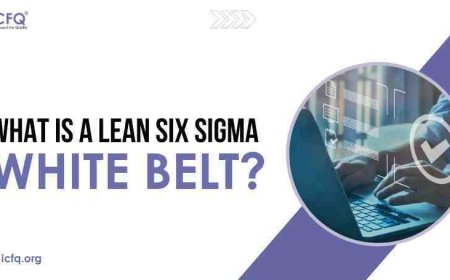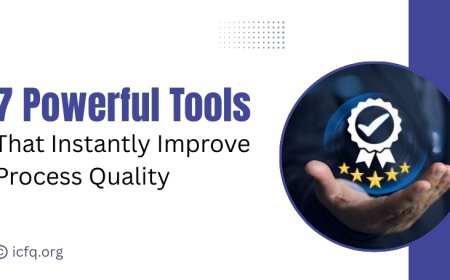Simplified Guide to Six Sigma Certifications
Explore our simplified guide to Six Sigma Certifications, covering key principles, certification levels, and benefits for career advancement.

Quality Assurance (QA) is a systematic process designed to determine whether a product or service meets specified requirements. In manufacturing, QA involves various activities like inspections, testing, and audits to ensure that products are manufactured to the required standards without defects. In technology, particularly in software development, QA focuses on identifying bugs in software before it is released, ensuring that it functions as intended and is user-friendly. In the service industry, QA ensures that service delivery meets customer expectations consistently and adheres to established standards. The overarching goal of QA is to enhance process reliability, maintain standards, and improve customer satisfaction by preventing mistakes or defects in manufactured products and ensuring that outputs are predictable and consistent.
Exploring Six Sigma Insights
Six Sigma is a methodology focused on enhancing quality and efficiency in business processes. Understanding what the certification entails is crucial for those considering it. It involves various levels, known as belts, each reflecting a degree of proficiency in Six Sigma methods. The belts range from Yellow to Green, Black, and Master Black Belt, with each level training participants in specific tools and techniques to reduce errors and improve quality.
For individuals, obtaining a Six Sigma certification can enhance job performance and applicability in roles requiring process management and quality control, increasing their value to employers and competitiveness in the job market. For businesses, having certified Six Sigma professionals can lead to more streamlined operations and cost savings, resulting in higher customer satisfaction. When pursuing Six Sigma certification, it's important to consider the alignment with personal career goals or business objectives and to choose a reputable training provider.
How do Six Sigma certifications help with quality assurance and what should you consider before getting one?
Six Sigma certifications are designed to provide individuals with a structured approach to process improvement, focusing on reducing variability in processes and eliminating defects. By training in Six Sigma methodologies, professionals can gain a thorough understanding of the techniques required to analyze and improve processes, which can simplify the approach to quality assurance by offering a clear, methodical framework.

When pursuing a Six Sigma certification, there are several key factors to consider:
-
Levels of Certification: Six Sigma offers different levels of certification, typically starting from Yellow Belt, moving up to Green Belt, and then to Black Belt and Master Black Belt. Each level requires a deeper knowledge of the methodology and more experience in implementing projects. Selecting the appropriate level depends on one's current role and career aspirations.
-
Accrediting Body: Various organizations offer Six Sigma certifications, such as the American Society for Quality (ASQ), the International Association for Six Sigma Certification (IASSC), and others. It's important to choose a reputable accrediting body recognized in your industry.
-
Training and Preparation: Consider whether you prefer self-study, online courses, or in-person training sessions. The choice might depend on your learning style, budget, and available time.
-
Project Requirement: For some certifications, particularly at the higher levels like Black Belt, you may be required to complete a practical project that demonstrates your ability to apply Six Sigma methodologies. This requirement is crucial as it provides hands-on experience.
-
Cost: Certification costs can vary widely depending on the accrediting body and the training provider. It’s necessary to factor in the cost of study materials, examination fees, and possibly re-certification down the line.
-
Career Impact: Reflect on how the certification will impact your career. For some, it might be a requirement for a promotion or an entry into a new field. For others, it might enhance their ability to contribute to their current roles.
How Can Six Sigma Certification Improve Quality Assurance?
Obtaining a Six Sigma certification can significantly enhance quality assurance processes by equipping individuals with a structured approach to problem-solving and process improvement. This certification teaches methodologies that focus on eliminating defects and reducing variability in processes. As a result, certified professionals can identify inefficiencies, analyze key aspects of production or service delivery, and implement changes that lead to higher-quality outputs. By applying these skills, organizations can achieve more consistent and reliable processes, which is essential for maintaining high standards in quality assurance.
The Role of Continuous Learning and Application
Continuous learning and practical application of skills are crucial for maintaining certification and driving professional growth. For certifications like Six Sigma, ongoing training helps individuals stay updated with the latest methodologies and tools essential for process improvement. This is not only a requirement to keep the certification valid but also ensures that professionals can continue to apply advanced techniques effectively in their work environments.
The regular application of these skills in real-world scenarios is equally important. It enables professionals to refine their abilities and adapt to new challenges, leading to enhanced problem-solving capabilities. This continual improvement is beneficial for both individual career advancement and the operational success of their organizations. Through sustained learning and application, professionals ensure they remain relevant and contribute effectively to their fields.
Checking certification body credibility and recognition
Assessing the credibility and recognition of certification bodies in an industry requires thorough research and consideration of several factors. Here's a guide to help you evaluate their credibility:
-
Accreditation: Look for certification bodies that are accredited by recognized accreditation bodies. Accreditation ensures that the certification body operates according to international standards and follows rigorous processes. Check if the certification body holds accreditation from bodies like ANSI, UKAS, JAS-ANZ, or similar reputable organizations.
-
Reputation: Research the reputation of the certification body within the industry. Check online reviews, testimonials, and feedback from professionals who have obtained certifications from them. Positive feedback and endorsements from industry experts can indicate credibility.
-
Industry Recognition: Determine whether the certification body's certifications are widely recognized and respected within the industry. Look for endorsements or partnerships with reputable organizations within the industry.
-
Transparency and Governance: Evaluate the transparency and governance practices of the certification body. Transparency in operations enhances credibility.
-
Quality of Content and Examination: Assess the quality of the certification content and examination process. High-quality content and examinations contribute to the credibility of certifications.

-
Continuing Education and Recertification: Consider whether the certification body requires ongoing education or recertification to maintain credentials. A certification body that emphasizes continuous learning and skill development demonstrates a commitment to maintaining standards and relevance in the industry.
-
Global Reach: Evaluate the global reach of the certification body. International recognition enhances the value of certifications and indicates credibility on a broader scale.
-
Legal Compliance: Ensure that the certification body complies with relevant laws and regulations governing certification practices in your region. Verify their legal status and check if they adhere to data protection and privacy laws.
-
Industry Stakeholder Engagement: Look for evidence of engagement with industry stakeholders such as professional associations, academic institutions, and regulatory bodies. Collaboration with key stakeholders can enhance the credibility and relevance of certifications.
-
Track Record and Longevity: Consider the certification body's track record and longevity in the industry. A long-standing history of operation and a proven track record can instill confidence in their credibility.
selecting the appropriate Six Sigma certification involves thorough research and consideration of factors such as accreditation, reputation, industry recognition, transparency, and quality assurance processes. It's essential to prioritize continuous improvement and quality assurance in professional development, ensuring ongoing skill enhancement and relevance in the industry. By choosing a certification that aligns with these principles, individuals can enhance their career prospects and contribute to organizational success through effective process improvement methodologies.




























